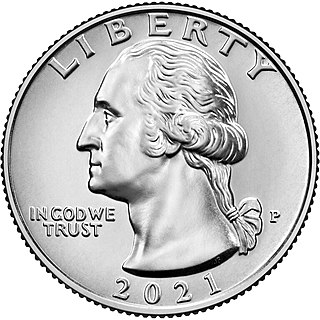
The quarter, short for quarter dollar, is a United States coin worth 25 cents, one-quarter of a dollar. The coin sports the profile of George Washington on its obverse, and after 1998 its reverse design has changed frequently. It has been produced on and off since 1796 and consistently since 1831.
Coins of the United States dollar were first minted in 1792. New coins have been produced annually and they make up a valuable aspect of the United States currency system. Today, circulating coins exist in denominations of 1¢, 5¢, 10¢, 25¢, 50¢, and $1.00. Also minted are bullion and commemorative coins. All of these are produced by the United States Mint. The coins are then sold to Federal Reserve Banks which in turn are responsible for putting coins into circulation and withdrawing them as demanded by the country's economy.

Precious metals are rare, naturally occurring metallic chemical elements of high economic value. Chemically, the precious metals tend to be less reactive than most elements. They are usually ductile and have a high lustre. Historically, precious metals were important as currency but are now regarded mainly as investment and industrial commodities. Gold, silver, platinum, and palladium each have an ISO 4217 currency code.

A nickel is a five-cent coin struck by the United States Mint. Composed of cupronickel, the piece has been issued since 1866. Its diameter is 0.835 inches (21.21 mm) and its thickness is 0.077 inches (1.95 mm).

The dime, in United States usage, is a ten-cent coin, one tenth of a United States dollar, labeled formally as "one dime". The denomination was first authorized by the Coinage Act of 1792. The dime is the smallest in diameter and is the thinnest of all U.S. coins currently minted for circulation, being 0.705 inches in diameter and 0.053 in (1.35 mm) in thickness. The obverse of the current dime depicts the profile of President Franklin D. Roosevelt and the reverse boasts an olive branch, a torch, and an oak branch, from left to right respectively. As of 2011, the dime coin cost 5.65 cents to produce.

The eagle was a United States $10 gold coin issued by the United States Mint from 1792 to 1933.
The fineness of a precious metal object represents the weight of fine metal therein, in proportion to the total weight which includes alloying base metals and any impurities. Alloy metals are added to increase hardness and durability of coins and jewelry, alter colors, decrease the cost per weight, or avoid the cost of high-purity refinement. For example, copper is added to the precious metal silver to make a more durable alloy for use in coins, housewares and jewelry. Coin silver, which was used for making silver coins in the past, contains 90% silver and 10% copper, by mass. Sterling silver contains 92.5% silver and 7.5% of other metals, usually copper, by mass.

The American Silver Eagle is the official silver bullion coin of the United States.

The American Gold Eagle is an official gold bullion coin of the United States. Authorized under the Gold Bullion Coin Act of 1985, it was first released by the United States Mint in 1986. Because the term "eagle" also is the official United States designation for pre-1933 ten dollars gold coins, the weight of the bullion coin is typically used when describing American Gold Eagles to avoid confusion. This is particularly true with the 1/4-oz American Gold Eagle, which has a marked face value of ten dollars.

The Morgan dollar is a United States dollar coin minted from 1878 to 1904, in 1921, and beginning again in 2021. It was the first standard silver dollar minted since the passage of the Coinage Act of 1873, which ended the free coining of silver and the production of the previous design, the Seated Liberty dollar. It contained 412.5 grains of 90% pure silver. The coin is named after its designer, United States Mint Assistant Engraver George T. Morgan. The obverse depicts a profile portrait representing Liberty, modeled by Anna Willess Williams, while the reverse depicts an eagle with wings outstretched. The mint mark, if present, appears on the reverse above between D and O in "Dollar".

Silver may be used as an investment like other precious metals. It has been regarded as a form of money and store of value for more than 4,000 years, although it lost its role as legal tender in developed countries when the use of the silver standard came to a final end in 1935. Some countries mint bullion and collector coins, however, such as the American Silver Eagle with nominal face values. In 2009, the main demand for silver was for industrial applications (40%), jewellery, bullion coins, and exchange-traded products. In 2011, the global silver reserves amounted to 530,000 tonnes.
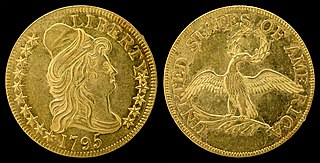
The half eagle is a United States coin that was produced for circulation from 1795 to 1929 and in commemorative and bullion coins since 1983. Composed almost entirely of gold, its face value of five dollars is half that of the eagle coin. Production of the half eagle was authorized by the Coinage Act of 1792, and it was the first gold coin minted by the United States.

The United States Mint has minted over 20 different kinds of coins, of many different sizes. Often, it is difficult for people to get a grasp of what much of the historical coinage looked like, at least in relation to modern circulating coins. This chart shows all of the coin types, and their sizes, grouped by coins of similar size and by general composition.

The Coinage Act of 1965, Pub.L. 89–81, 79 Stat. 254, enacted July 23, 1965, eliminated silver from the circulating United States dime and quarter dollar coins. It also reduced the silver content of the half dollar from 90 percent to 40 percent; silver in the half dollar was subsequently eliminated by a 1970 law.

The United States dollar is the official currency of the United States and its territories. The Coinage Act of 1792 introduced the U.S. dollar at par with the Spanish silver dollar, divided it into 100 cents, and authorized the minting of coins denominated in dollars and cents. U.S. banknotes are issued in the form of Federal Reserve Notes, popularly called greenbacks due to their predominantly green color.
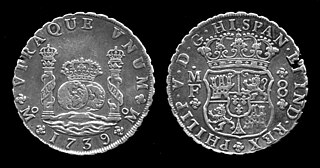
The numismatic history of the United States began with Colonial coins such as the pine tree shilling and paper money; most notably the foreign but widely accepted Spanish piece of eight, ultimately descended from the Joachimsthaler and the direct ancestor of the U.S. Dollar.
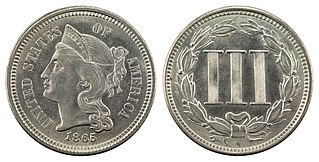
The copper-nickel three-cent piece, often called a three-cent nickel piece or three-cent nickel, was designed by US Mint Chief Engraver James B. Longacre and struck by the United States Bureau of the Mint from 1865 to 1889. It was initially popular, but its place in commerce was supplanted by the five-cent piece, or nickel.

A gold coin is a coin that is made mostly or entirely of gold. Most gold coins minted since 1800 are 90–92% gold, while most of today's gold bullion coins are pure gold, such as the Britannia, Canadian Maple Leaf, and American Buffalo. Alloyed gold coins, like the American Gold Eagle and South African Krugerrand, are typically 91.7% gold by weight, with the remainder being silver and copper.
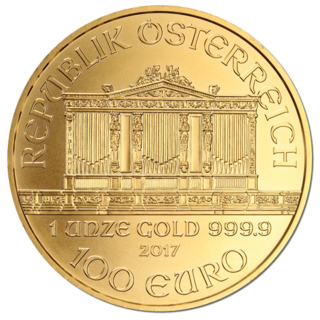
The Vienna Philharmonic, often shortened to Philharmonic, is a bullion coin of gold, silver, or platinum produced by the Austrian Mint. The coin is named for the Vienna Philharmonic orchestra, which inspired the design of both sides. It was introduced in 1989 as a one-troy ounce (ozt), gold coin with a face value of 2,000 Austrian schillings. It is generally one of the world's best selling bullion coins. In 2002, with the adoption of the euro currency, the nominal value of the one-ounce coin was changed to 100 euros. In 2008, the Mint introduced a one-ounce silver version of the coin with a nominal value of 1.50 euros. The silver coin is also one of the top selling bullion coins, ranked third in 2013. In 2016, the mint introduced a one ounce platinum coin with a face value of 100 euros.

Actual silver weight, usually abbreviated ASW, refers to the weight of pure silver contained in a coin, measured in troy ounces.



















